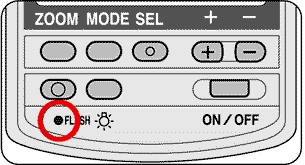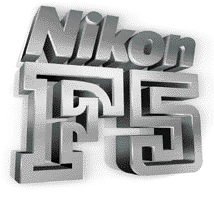Taking flash photographs in the Auto Aperture (AA) mode for Digital SLR and Kodak DCS600 Series cameras In this mode, the correct exposure for both subject and background is automatically obtained. The SB-28DX’s built-in sensor controls the flash output in combination with data transmitted from the camera and lens to the SB-28DX, including the ISO sensitivity level, aperture, focal length, and exposure compensation value. Note: AA (Auto Aperture) mode only works when using the Digital SLR or DCS600 Series cameras when Nikkor lenses with a built-in CPU (except IX Nikkor lenses and AF Nikkor lenses for the F3AF) are mounted. The AA mode is automatically switched to Non-TTL Auto Flash A mode when Nikkor lenses without a built-in CPU are mounted.
Camera settings
1. Set the ISO sensitivity level.
2.Set the exposure mode to A (Aperture-priority) or P (Programmed auto). When
using the M (Manual) or S (Shutter-priority auto) exposure mode, make
sure the aperture is within the range.
3. Set the aperture. In A (Aperture-priority auto) exposure mode: Set the
lens aperture to its minimum. Then set the aperture on the camera. Refer to “Table
2: Usable aperture/flash shooting distance ranges in AA (Auto Aperture) and A (non-TTL
Auto Flash) modes.” In P (Programmed auto) exposure mode: Set the lens aperture to
its minimum.
Note: In either exposure mode, if the aperture is out of the range, the aperture
value, exposure compensation indicator and exposure compensation value on the LCD
panel blink and the flash shooting distance range indictor bars disappear to warn
you. In this case, adjust the aperture and shooting distance by referring to Table
2.
SB-28DX settings:
4. Select the flash mode.
Press the ![]() button until
button until ![]() ·appears on the LCD panel in either AA (Auto
Aperture) or A (non-TTL auto) mode. In AA mode, the exposure compensation indicator
and exposure compensation value appear on the LCD panel simultaneously. Note: When
the flash unit is mounted on the Kodak DCS620 camera and turned on for the first
time, the AA mode is always activated.
·appears on the LCD panel in either AA (Auto
Aperture) or A (non-TTL auto) mode. In AA mode, the exposure compensation indicator
and exposure compensation value appear on the LCD panel simultaneously. Note: When
the flash unit is mounted on the Kodak DCS620 camera and turned on for the first
time, the AA mode is always activated.
 |
5. Wait for the ready-light to come on before taking the picture. If the ready-light blinks for approx. 3 seconds after the picture is taken, this indicates the flash fired at maximum output, meaning that light may have been insufficient for correct exposure. In that case, use a wider aperture or move closer to the subject before taking the next picture by referring to Table 2. |
To check the correct flash shooting distance range before taking the picture Point
the camera at the subject. After pressing the shutter release button lightly, press
the ![]() button on the SB-28DX. If the ready-light blinks for approx. 3 seconds,
this indicates the flash fired at maximum output, meaning that light may have been
insufficient for correct exposure. In this case, use a wider aperture or move closer
to the subject by referring to Table 2 before taking the actual picture.
button on the SB-28DX. If the ready-light blinks for approx. 3 seconds,
this indicates the flash fired at maximum output, meaning that light may have been
insufficient for correct exposure. In this case, use a wider aperture or move closer
to the subject by referring to Table 2 before taking the actual picture.
 |
Table 2: Usable aperture/flash shooting distance ranges in AA (Auto Aperture) and A (non-TTL Auto Flash) modes Use this table to determine the distance range in which the correct auto flash exposure will be obtained at various ISO sensitivity levels, aperture, and zoom settings. |
Flash exposure compensation In AA mode, flash output compensation is possible in 1/3 steps from -3.0 to +1.0EV by pressing the { or } button to increase or decrease the compensation while confirming the amount on the LCD panel. Note that flash output compensation is restricted in Zones A to D. Zone A: Minus flash output compensation is not possible. Zone B: Flash output compensation exceeding -1EV is not possible. Zone C: Flash output compensation exceeding -2EV is not possible. Zone D: Flash output compensation from 0 to +1EV is not possible.
Note*: If flash output compensation is made exceeding the amount of the above values, the flash shooting range indicator bars disappear and the aperture, exposure compensation indicator, and exposure compensation value blink to warn you. Note**: Exposure compensation on the camera is possible. Refer to your camera’s instruction manual for information. Note***: Exposure compensation can be made on both the SB-28DX and the camera. The exposure is controlled by the sum total of both exposure compensation values and the shooting range indicator bars changes to match the exposure compensation. However, the SB-28DX’s LCD panel displays the amount of compensation set on the SB-28DX only.
ISO 200 guide numbers (m/ft) in the Manual and Repeating Flash Modes (at 20°C/68°F)
 |
Adjustment factors for other ISO sensitivity levels |
| Previous | 2/2 | NEXT | Nikon SB-29(s) Macro Speedlight or the digital-ready Nikon SB-50DX
| Back | Index Page The Nikon F5 SB-28DX Instruction manual
| Back | Index Page The Nikon F5 SB-28 Instruction
manual
Relative:
Nikon AF-TTL Speedlight Models: Nikon SB-800 | Nikon SB-600 | Nikon SB-30 | Nikon
SB-29(s)
(2000) | Nikon SB-28 (1997) |
Nikon
SB-27 (1997)
| Nikon
SB-26
(1994) | Nikon SB-25 (1992) |
Nikon
SB-24 (1988) |
SB-23 | SB-22
(1987) |
SB-20 (1986)
Nikon AF-TTL Speedlight DX-Series: Nikon SB-28DX (1999)| SB-50DX (2001) |
SB-80DX (2002)
Additional information on various Nikon MF Bulb Flash - Nikon MF-Speedlights
SB-1 ~ SB-21A/B
| Back | Main Index Page - Nikon F5 Professional SLR camera
The Camera - Background,
Issues & Summary
Basic
Features | Focusing | Metering Systems | Exposure Control | Reliability Issues | Nikkor lens Compatibility
Prisms/Finders - Index page
- 2 parts
Film Backs: Index
Page - 1 parts
Focusing Screens - Index Page
- 1 part
Flash System - Index
Page
- 3 parts
System Accessories: | Power Sources | Cases | Remote
Control | Miscellaneous
Macro
Photography
- Related info on Micro-Nikkor lenses
Technical Specification for Nikon F5
Main
Reference Map
/ Nomenclature
Resource Centre:
Instruction Manuals
Nikon
F5 Camera Body
- 18
parts
MF-28
Multi-Function Back
HTML - 8
parts
PC
Links - Photo Secretary
- 2
parts
AF-TTL Speedlights:
SB-28 / SB28DX | SB29(s) info | SB30 | SB50DX | SB80DX | SB600 info | SB800
Variants: F5 50th Anniversary Model | Nikon/Kodak DCS-620 | DCS-720 Digital Still SLR camera
| Back | Index Page of Digital
Nikon SLR cameras
|
Back | Main Index Page of Pictorial
History of Nikon SLR cameras
![]()
| Nikon F | Nikon F2 | Nikon F3 | Nikon F4 | Nikon F5 | Nikon F6 | Nikkormat / Nikomat | Nikon FM | Nikon FE/ FA | Nikon EM/FG/FG20 | Nikon Digital SLRs | Nikon - Other models |
The Eyes of Nikon:-
Nikon Auto Focus Nikkor lenses:- Main
Index Page
Nikon Manual Focus Nikkor lenses:- Fisheye-Nikkor Lenses - Circular | Full Frame |
Ultrawides Lenses - 13mm15mm18mm20mm | Wideangle Lenses - 24mm28mm35mm | Standard Lenses - 45mm 50mm 58mm | Telephoto
Lenses - 85mm105mm135mm180mm & 200mm | Super-Telephoto Lenses - 300mm 400mm 500mm 600mm 800mm 1200mm |
 Index Page |
Special
Application lenses: Micro-Nikkor Lenses - 50mm~55mm -60mm 85mm -105mm 200mm Micro-Zoom 70-180mm Perspective Control (PC) - 28mm 35mm PC-Micro 85mm Dedicated Lenses for Nikon F3AF: AF 80mm f/2.8 | AF 200mm f/3.5 EDIF Depth of Field Control (DC): 105mm 135mm Medical Nikkor: 120mm 200mm Reflex-Nikkor Lenses - 500mm 1000mm 2000mm Others: Noct Nikkor | OP-Nikkor | UV Nikkor 55mm 105mm | Focusing Units | Bellows-Nikkor 105mm 135mm Nikon Series E Lenses: 28mm35mm50mm100mm135mm | E-Series Zoom lenses: 36~72mm75~150mm70~210mm |
MF Zoom-Nikkor Lenses: 25~50mm | 28~45mm | 28~50mm | 28~85mm | 35~70mm | 36~72mm E | 35~85mm | 35~105mm | 35~135mm | 35~200mm | 43~86mm | 50~135mm | 50~300mm | 70~210mm E | 75~150mm E | 80~200mm | 85~250mm | 100~300mm | 180~600mm | 200~400mm | 200~600mm | 360~1200mm | 1200~1700mm
Tele-Converters: TC-1 | TC-2 | TC-200 | TC-201 | TC-300 | TC-301 | TC-14 | TC-14A | TC-14B | TC-14C | TC-14E | TC-16 | TC-16A | TC-20E
Recommended links to understand more technical details
related to the Nikkor F-mount and production Serial Number:
http://rick_oleson.tripod.com/index-153.html by: my
friend, Rick Oleson
http://www.zi.ku.dk/personal/lhhansen/photo/fmount.htm by: Hansen,
Lars Holst
http://www.mir.com.my/rb/photography/hardwares/nikonfmount/lens2.htm
http://www.photosynthesis.co.nz/nikon/serialno.html
 |
| Message Board | for Nikon F5 Series SLR model(s) | |
About this photographic site.
HOME - Photography in Malaysia |
![]()
A resource dedicated to my kids, Alvin Foo & Esther Foo- one day,
BOTH might need to use all these information for his/her Nikon F5A camera.
Volunteered Maintainer(s) for the Nikon F5 Message Board: Tony Davies-Patrick, UK; Rick Oleson, US; Koh Kho King, Malaysia.
Credit: Mr. Chuck Hester, US for his text re-editing skill for this site; Our staff, HowKiat® who created the 3D-Nikon F5 logo. Mr. Lew Chee Wai of YL camera for lending his F5 for me to take some shots appeared in this site. All those nice folks who have contributed their images, in particular Mr. Mike Long, Edwin leong, Palmi Einarsson, Sergio Pessolano, Fred Kamphues, Harry Eggens, Curtis Forrester, Nick (Natures Moments), Sandra Bartocha; fellow countrymen, Vincent Thian, Koh Kho King, Philip Chong, CY Leow etc. and contributions from a few nice folks from Photo Malaysia Forum. Disclaimers & acknowledgments: Certain content and images appeared in this site were either scanned from official marketing leaflets, brochures published by Nikon and/or contribution from surfers who claimed originality of their own work for public publishing in this website, where majority of the extracted information are used basing on educational merits. The creator of this site will not be responsible for any discrepancies that may arise from any possible dispute except rectifying them after verification from respective source. Neither Nikon or its associates has granted any permission(s) in using their public information nor has any interest in the creation of this site. "Nikon", "Nikkormat", "Nippon Kokagu KK" "Silent Wave", "Focus Tracking Lock-on", "Nikkor" & other applicable technical/business terms are registered trade name(s) of Nikon Corporation Inc., Japan. Site made with an Apple G5 IMac.